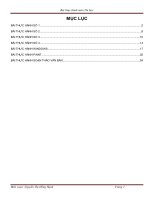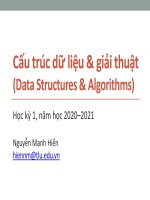2021 lecture01 introductiontoai
Bạn đang xem bản rút gọn của tài liệu. Xem và tải ngay bản đầy đủ của tài liệu tại đây (3.86 MB, 50 trang )
Artificial Intelligence
INTRODUCTION TO
ARTIFICIAL INTELLIGENCE
Nguyễn Ngọc Thảo – Nguyễn Hải Minh
{nnthao, nhminh}@fit.hcmus.edu.vn
Outline
• What is Artificial Intelligence (AI)?
• The foundations of AI
• A brief history of AI
• AI applications in various fields
• What are we going to learn?
2
What is AI?
3
AI: A dream for everyone
4
AI Innovations: Personal robots
Source: />5
AI Innovations: Humanoid robots
Source: />6
AI Innovations: Deep Blue – AlphaGo
AlphaGo vs. Lee Sedol
(03/2016)
Deep Blue vs. Kasparov
(02/1996 and 05/1997)
7
The complexity of Chess and GO
Source: />8
AI Innovations: OpenAI Five
Source: />
9
Intelligence vs. Artificial Intelligence
Intelligence includes the capacity for logic, understanding,
learning, reasoning, creativity, and problem solving, etc.
Artificial intelligence (AI) attempts not just to understand
but also to build intelligent entities.
10
The field of Artificial Intelligence
• AI is one of the newest fields in science and engineering.
• Work started in earnest soon after World War II
• The name was coined at a conference at Dartmouth College in 1956.
John McCarthy
(1927 – 2011)
Marvin Minsky
(1927 – 2016)
Allen Newell
(1927 – 1992)
Arthur Samuel
(1901 – 1990)
Herbert Simon
(1916 – 2001)
11
The field of Artificial Intelligence
• AI research builds intelligent entities that simulate humans
in different aspects.
✓ Thinking: learning, planning, and
refining knowledge
✓ Perception: see, hear, feel, etc.
✓ Communication in natural languages
✓ Manipulation and moving objects
12
What is Artificial Intelligence?
13
What is Artificial Intelligence?
Systems that
think
like humans
Systems that
think
rationally
Systems that
act
like humans
Systems that
act
rationally
Behavior
Rationality
Humans
Thought processes and reasoning
14
Systems that act like humans
• The Turing Test approach (Alan Turing, 1950)
A computer passes the test if a human interrogator, after posing several written
questions, cannot tell whether the written responses come from a person or from a
computer.
15
Systems that act like humans
• Problems with the Turing Test
nin ig n
hu n
h io
Tu ing
n
ig n
h io
hu n
on o
• Variations
• Reverse Turing Test: CAPTCHA
• Total Turing Test: additionally examine the perceptual (computer
vision) and the objects manipulation (robotics) abilities of the subject.
16
Turing Test: Variations
• Reverse Turing Test: CAPTCHA
17
Turing Test: Variations
• Total Turing Test: additionally examine the perceptual
(computer vision) and the objects manipulation (robotics)
abilities of the subject.
Sheep dog
or mop?
18
A better Turing Test?
• AI researchers have devoted little effort to pass the test.
• It is more important to study the underlying principles of
intelligence than to duplicate an exemplar.
Image credit
19
Systems that think like humans
• General Problem Solver – GPS (Newell and Simon, 1961)
• Not merely solve problems correctly
• Compare the trace of its reasoning steps to traces of human subjects
while solving the same problems
• Cognitive Science
• Computer models from AI
• Experimental techniques from psychology
precise and testable
theories of
the human mind
• These approaches are now distinct from AI
• Share the available theories but do not explain anything resembling
human intelligence
• All share a principal direction
20
Systems that think rationally
• The laws of thought approach
• “Righ hinking” = irrefutable reasoning processes
• E.g., A i o ’ syllogisms provided patterns for argument structures
that always yielded correct conclusions when given correct premises.
All men are mortal. x.man(x) mortal(x)
Socrates is a man.
man(Socrates)
Therefore,
Socrates is mortal. mortal(Socrates)
Aristotle
(381BC – 322BC)
21
Systems that think rationally
• Problems with the logicist approach
• Not all intelligence is mediated by logic behavior
• Solving a problem “in p incip ” is different from doing in practice
• Both obstacles apply to any attempt to build computational
reasoning systems
22
Systems that act rationally
• The rational agent approach
• Rational behavior = “ oing the right thing”,
• “Right thing”: what is expected to maximize goal achievement given
the available information
• An agent is just something that perceives and then acts
𝒇: 𝓟 → 𝓐
• A rational agent acts to achieve the best outcome or, when
there is uncertainty, the best expected outcome.
• Include thinking, inference as a part of being rational agent
• Include more: action without thinking, e.g., reflexes
23
Systems that act rationally
• More general than the “ w of hough ” approach
• Correct inference is not all of rationality.
• In some situations, there is no provably correct thing to do, but
something must still be done.
• Amenable to scientific development than those based on
human behavior or human thought
24
Major roles and Goals of AI
Goals of AI
AI studies the intelligent part concerned with human and
represents those actions using computers.
25









